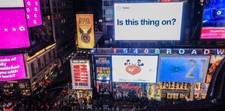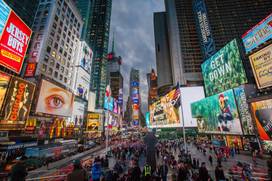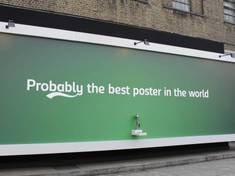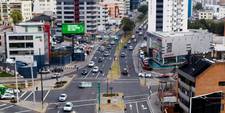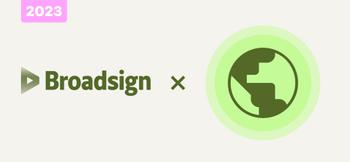Despite out-of-home (OOH) advertising increasing by 6.8% in the first quarter of 2024 compared to the previous year, one of the first questions we’re often asked by media buyers remains: “How much does outdoor advertising cost?” and, more specifically, “How much does it cost to get my ad on a billboard?”
Unfortunately, the answer isn’t straightforward, as billboard advertising costs vary and depend on several factors, including location, circulation, size, format, and audience demographics. Traditional (i.e., static) billboards, however, can run from $1,000 to $2,000 a month for campaigns in rural areas, $1,500-$5,000 in small to midsize cities, and $14,000 and up in larger markets. Digital billboards, on the other hand, which often feature four or five adverts that alternate during a single, 60-second period, can cost anywhere from $770 per month to over $10,000 a day, depending on the billboard’s location, ad duration, and frequency.
Looking for a specific city? Explore popular billboard locations here.
In this comprehensive guide, we unravel the key determinants shaping billboard advertising cost, demystifying concepts like CPM (Cost Per Thousand Impressions) and exploring approaches and tactics to help businesses maximize their return on investment. We’ve also divided this blog into sections so you can easily find the information you’re looking for.
- Benefits of billboard advertising
- Understanding CPM for billboards
- Factors that affect billboard advertising costs
- Billboard campaign creation & activation strategies to optimize ROI
Benefits of billboard advertising
Billboard advertising is a popular form of OOH advertising that can effectively reach a wide audience. Some of the notable advantages of billboard advertising include:
High visibility: Billboards are large and visually striking (see our favourite OOH and billboard ads), making them difficult to ignore. They can capture the attention of drivers, pedestrians, and public transit users. According to the Out of Home Advertising Association of America (OAAA), 81% of U.S. travelers have noticed a billboard in the past month and 80% have noticed OOH ads in the past week.
Wide reach: Billboards located in high-traffic areas like highways, city centers, and busy streets can reach a broad audience, including people from various demographics. This includes people who might not be reachable through online advertising. As a result, billboards can be a powerful, cost-effective way to create brand awareness and reinforce brand recognition over time.
Unskippable and ad-block-proof: The tangible nature of billboards means they can’t be easily dismissed like a pop-up or banner ad on a screen. This physical presence makes them a more persistent and memorable form of advertising. According to Solomon Partners’ 2023 benchmark report, OOH produces the highest levels of consumer recall compared to other media channels — surpassing traditional mediums like print, podcasts/radio, and television, as well as online executions via desktop and mobile.
Contextual relevance: Billboards can be strategically placed in specific locations to target local audiences effectively or leverage proximity to relevant locations, like placing a restaurant ad near a highway exit leading to the restaurant. This is especially impactful considering that over two-thirds (68%) of U.S. shoppers notice OOH ads while en route to retailers or right outside a store.
Drives real-world action: Nearly 80% of consumers have engaged with an OOH ad in the past 60 days, according to an OAAA and Morning Consult survey. Over three-quarters (76%) used a mobile device to learn more about a product featured in an OOH ad, just over half (51%) used their mobile device to search for more information about an advertiser, and 43% made an online purchase.
Traditional (static) billboards vs digital billboards
Physical billboards offer several advantages over digital billboards. For one, physical billboards are often easier to set up since the infrastructure has been in place for decades in the US. Additionally, printed advertisements are not susceptible to glitches or power outages, unlike their digital counterparts.
However, digital billboards have their own set of benefits. They are more dynamic, often animated, and can be more attention-grabbing. Digital billboards can also be targeted based on the time of day and other factors, making them more effective in some cases. Moreover, digital ads provide affordable billboard options for small businesses with limited budgets since you’re splitting the cost with other advertisers for a shared display.
Let’s take a look at the characteristics of each type:
Static billboards
- High-visibility, especially in high-traffic areas
- Broad, mass audience reach
- Long-term exposure
- Localized geographic targeting
- Low content flexibility, static content
- Low ad fraud and ad blocker vulnerability
- Typically has a lower CPM
Digital billboards
- High-visibility, especially in high-traffic areas
- Broad, mass audience reach
- Long-term exposure, but ads can change frequently
- Localized, specific locations OR highly precise audience- and location-based targeting
- High content flexibility
- Low ad fraud and ad blocker vulnerability
- Cost is variable depending on location and ad duration
Understanding CPM for billboards
In the world of billboard advertising, CPM (Cost Per Thousand Impressions) plays a vital role in determining the cost-effectiveness and reach of an outdoor campaign. It’s a widely used metric that calculates an advertiser’s cost for every one thousand impressions received on a billboard.
Impressions represent the number of times an ad is potentially viewed by people passing by. Essentially, one impression is meant to correspond to one person viewing the billboard one time, making CPM a critical measure of an ad’s efficiency in capturing the attention of its target audience.
To calculate CPM rates for billboards in out-of-home (OOH) advertising, advertisers need to divide the total cost of the billboard campaign by the number of impressions it generates (in thousands). For example, if a billboard campaign costs $5,000 and generates 300,000 impressions, the CPM would be calculated as follows:
CPM = (Total Cost of Campaign / Impressions) x 1000
CPM = ($5,000 / 300) x 1000
CPM = $16.67
Though this is a good illustrative example, in reality, the average CPM for billboards tends to be much lower, especially in comparison to other media. According to Solomon Partners’ 2023 Media Trends Report, in the U.S., you can expect to pay an average of USD$2-9 per thousand impressions for an OOH bulletin, poster, transit shelter, or digital place-based ad. This variability in pricing means it’s important to understand just where and when you want to reach people with an OOH campaign before you set a budget. OOH inventory is found in cities, roadside, and malls – they’re a part of our daily landscape and provide a level of visibility not available to other types of media.
Want to dig into OOH metrics a little deeper? Check out this blog post.
Factors affecting billboard costs
There are a number of variables that impact the CPM for billboards, including the location of the billboard, its size, traffic volume in the area, and the type of audience it attracts. By comprehending the factors influencing CPM and optimizing their campaigns accordingly, advertisers can strike the right balance between cost and reach, ultimately enhancing their ROI on billboard advertising.
Billboard location
It should come as no surprise that one of the major elements that determine the price of a billboard is its location. After all, a prominent and highly visible location constitutes a decisive benefit for your business – the right spot means your messaging can reach thousands.
If a billboard is located in a premium area like an urban center, it’ll likely cost more than it would in other locations. Similarly, a placement installed along a major roadway will affect pricing, too. Also, the side of the road your OOH signage is located on will also have an impact, as the signage will either be directly visible to oncoming traffic or not. Additionally, market saturation might lead to more competitive pricing in areas with a high concentration of billboards as advertisers vie for limited premium spaces.
The “right” location for an ad is going to depend heavily on what is being advertised. While a fast-fashion ad will feel right at home in the heart of Times Square, you wouldn’t likely be purchasing space for the same product along a rural highway.
Billboard sizes
Billboard size matters significantly in pricing. Larger billboards offer more prominent displays and greater visual impact, leading to higher costs compared to smaller ones. Advertisers must strike a balance between size, location, and budget to find the most effective combination for their marketing objectives.
Billboards come in many different shapes and dimensions, but we’ll break them down into basic categories to give you an idea of what to expect:
Spectaculars
These spectacularly large billboards are specially designed to grab attention in high-traffic areas like Times Square.
Common sizes include:
- 20’ h x 60’ w
- 16’ h x 60’ w
Because they’re typically used by large national brands with equally spectacular advertising budgets, they can have custom dimensions and often use special effects to guarantee people will stop and take notice.
While these are, as advertised, spectacularly huge, they can also be spectacularly expensive. Luckily, most businesses probably don’t need something quite this huge to achieve their campaign goals.
Bulletins
The most popular billboard size (and likely the type most people picture when they hear the word “billboard”), bulletins are best suited for large roads and busy highways.
Though not quite as big as a spectacular, they’re still very large and eye-catching—and are available to rent in many more locations around the country.
Standard bulletin sizes:
- 14’ h x 48’ w
- 10’ h x 40’ w
- 10’6” h x 36’ w
Average CPM (according to the OAAA):
- Static: $3-6
- Digital: up to $8
When renting a bulletin, there are considerations beyond size and location—for example, longevity. Bulletins are also large enough that, like spectaculars, they can be customized in eye-catching ways. Just keep in mind that any kind of customization = more time and added installation and design costs.
Posters
If your goal is more targeted advertising, a poster (also called a 30 sheet) or a junior poster (also called an 8 sheet) are both options that are a bit smaller than a bulletin and better suited for smaller spaces and local roads.
While these placements may not be seen by as many people, by being more targeted they can prove more effective in helping you achieve certain campaign goals.
Standard poster sizes:
- 12’3” x 24’6” w
- 6” x 12’ w (junior)
Average CPM (according to the OAAA):
- Static: $2-6
- Digital: up to $7
Billboard traffic count
Another consideration in the pricing of billboard advertising is circulation, since the volume of traffic passing by a billboard (i.e., its traffic count) directly affects its value. This metric tracks the number of passersby exposed to a billboard or out-of-home signage in a specific region or market. Higher traffic counts translate to more impressions and potential customer exposure, making billboards in heavily travelled areas more expensive.
Media owners work with local municipalities and transportation authorities to count the number of cars going by, tracking the circulation rate while considering certain elements. For example, if the vehicle is moving past the billboard in the morning, it’s typically presumed that the driver is alone in the car as they are likely commuting to work. That means it’s a single view. Many of the newer, more technologically advanced digital billboards also include in-screen data sensors that can help provide a more accurate traffic count and aid in measuring the number of delivered impressions.
Within the industry, innovation and first-party data integration have led to improved measurement and understanding of these metrics, with a growing number of companies and third-party software providers increasingly performing deep analyses to accurately assess any particular billboard’s traffic count and circulation.
Takeaway: Higher traffic counts = more potential customer exposure and typically higher pricing.
Audience demographics
As is the case with many different advertising formats, demographics are going to play a part in the pricing of your signage.
Demographics determine the breakdown of age, gender, purchasing habits and income bracket for potential consumers. Pooling and analyzing these metrics can help advertisers recognize who is more likely to see their ad.
An example of when audience demographics come into play is when you have a billboard that’s positioned near an affluent part of town or in an environment in which a lot of affluent people work. These billboards will be more likely to cost a little more, given that the neighbourhood’s residents probably have higher disposable income.
Takeaway: Attributes of a billboard’s audience demographics that can increase OOH ad pricing include:
- Affluence/higher disposable income
- Strategically positioned to target a specific demographic group
- Demand for proximate audience types
Seasonal demand
The seasonal demand for certain billboards can also influence pricing. For instance, billboards near popular vacation spots might experience increased rates during peak tourist seasons. On the other hand, some advertisers may opt for off-peak periods to secure more cost-effective campaigns.
Additional expenses and considerations
Beyond the base cost of billboard advertising, there are several additional expenses and crucial considerations that advertisers must take into account to execute successful OOH campaigns.
Billboard design plays a pivotal role in catching the attention of passersby, and investing in captivating visuals and compelling messaging is essential. However, this incurs its own costs, ranging from graphic design fees to high-quality printing expenses. It is vital to allocate a portion of the budget for a professional, eye-catching billboard design that effectively conveys the intended message.
If you decide to go with a static billboard, then production and installation costs are other critical factors to consider when planning your campaign. Crafting a durable billboard that can withstand various weather conditions is crucial for ensuring its longevity and message retention. The production process may involve weatherproofing materials and additional construction expenses to ensure the billboard remains in optimal condition throughout the campaign’s duration.
Additionally, advertisers must carefully review the contract details with the billboard owner or operator, as hidden or unforeseen fees might arise, impacting the overall campaign budget.
Streamline campaign creation & activation to optimize ROI
Maximizing the return on investment is the ultimate goal for any advertising campaign, and billboard advertising offers a powerful avenue to achieve just that. But in the rapidly evolving OOH landscape, mastering the art of campaign creation and activation is crucial to unlocking optimal ROI.
Campaign planning & asset creation
To optimize ROI with OOH billboards, businesses must begin with strategic planning. Thoroughly researching target audience demographics, traffic patterns, and competitor insights will help advertisers identify prime billboard locations that guarantee maximum visibility and engagement.
Crafting compelling and memorable creative content is equally crucial, as it can captivate audiences and leave a lasting impression. By aligning the billboard’s message with the brand’s identity and campaign objectives, businesses can foster stronger connections with potential customers, ultimately enhancing ROI.
Leveraging data to track & maximize impact
Measuring campaign effectiveness is another critical step in optimizing ROI for OOH billboard advertising. Employing tools like unique URLs or dedicated QR codes in the billboard design can help track the response and impact of the campaign. Regularly analyzing campaign performance and adjusting strategies based on the collected data can help fine-tune billboard placements, creative elements and overall messaging to deliver better results.
Additionally, leveraging digital billboards that allow dynamic content changes based on time of day or audience demographics enables advertisers to adapt their messages for maximum relevance, further boosting ROI. And while it’s not, strictly speaking, a prerequisite for running dynamic ads on digital out-of-home billboards, programmatic enablement (pDOOH) gives advertisers additional opportunities to launch dynamic and interactive DOOH campaigns.
Activate campaigns at scale with dedicated OOH tools & software
Programmatic digital OOH offers streamlined campaign management and seamless integration into broader campaigns through omnichannel or specific demand-side platforms (DSPs). These user-friendly tools enable advertisers to quickly move from idea to execution, ensuring an easy and cost-effective turnaround.
Technology is also helping to simplify and streamline the turnaround for static billboards, which continue to depend on labour-intensive buying processes and typically involve a lot of back-and-forth emails and phone calls. With the introduction of dedicated static campaign management software, media owners now have access to things like real-time inventory availability and streamlined scheduling tools, allowing them to create and deliver static billboard campaigns faster, which can also help you save money on overall turnaround costs.
By continuously refining their approach and making data-driven decisions, and by choosing a media partner or DSP that’s equipped to handle any kind of billboard campaign request, businesses can unlock the full potential of OOH billboard advertising to achieve remarkable ROI and make a significant impact in the market.

